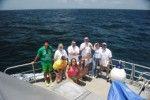A summer on Texas’s Gulf Coast is typically known for its popular beaches in Galveston or South Padre Island, not a lack of oxygen in the water.
A team of 10 Texas A&M scientists and graduate students embarked on an annual six-day research cruise in June to confirm and study the growth of large regions of hypoxia – oxygen depletion in the water – across the Texas and Louisiana coast.
Led by principal investigator Steven DiMarco, associate professor in the Department of Oceanography, the cruise extended from Matagorda, Texas, up to Southwest Pass delta and Lake Charles in Louisiana.
DiMarco described a hypoxic region, or “dead zone,” as a natural occurrence in summer months when the air is still, and fresh saltwater forms into stratified layers. The hypoxia disallows the mixture of oxygen in the water, making the lower layer unable to support sea life. DiMarco noted that fish, crab, and especially shrimp, could become susceptible to these unsustainable conditions.
Although dead zones have been monitored since 1985, funding from the National Oceanic and Atmospheric Association began in 2003 for continued monitoring and
prediction making.
“Our main contribution is quantifying and determining the processes of what contributes to the dead zone,” DiMarco said.
DiMarco and his team utilized a tool named “The Acrobat,” an instrument that moved through the water column in order to measure oxygen, salinity, temperature and chlorophyll.
Heather Zimmerle, a graduate student on the team, operated the Acrobat during the night hours.
“It was really important to make sure we were able to collect the data,” Zimmerle said. “Without it, we might not have been able to see all that hypoxia at that time.”
Natural causes help create dead zones, however, concerns have been raised by commercial fisheries because of the excess fertilizer and other chemicals from farming runoff in rivers like the Mississippi and Brazos, and eventually into the ocean.
DiMarco described the nitrates from fertilizers as “fueling” algae growth. Once it begins to decay and die, they sink and the microorganisms eat the remnants.
“Because the dead zone is driven by microbial processes, they respire oxygen out of water,” DiMarco said. That’s when it gets lethal for commercially viable species.”
Laura Harred, a graduate student onboard the research cruise, examined the abundance of algae, specifically in the Port Aransas area, using an Imaging Flow Cytobot.
“If we see an abundance of phytoplankton in a place, we might expect in the future there might be a large hypoxic area,” Harred said.
DiMarco said the NOAA encourages farmers to reduce the amount of fertilizer used. However the action is voluntary for the farmers. Zimmerle mentioned that regulation in the future could be possible, but enforcement would be difficult.
“It would be hard to enforce such a large area,” Zimmerle said. “There are a lot of rivers that dump into the Mississippi watershed. I think the research will be more of a general awareness used for farmers.”
Both Harred and Zimmerle agreed that knowledge of the hypoxia situation should be more widespread.
“A lot of people use fertilizer for their lawns,” Zimmerle said. “It would be good for the general public to know the importance of what they are doing to the environment.”
Exploring the dead zones
July 17, 2013

Donate to The Battalion
Your donation will support the student journalists of Texas A&M University - College Station. Your contribution will allow us to purchase equipment and cover our annual website hosting costs.



















